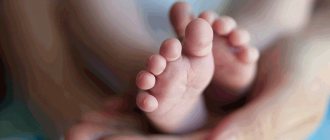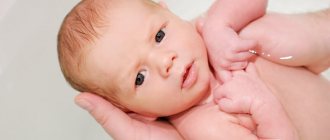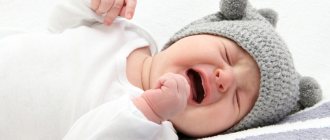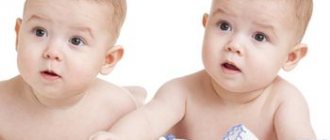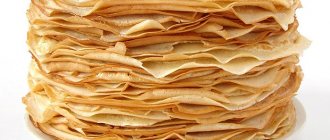Having become parents and being left alone at home with a newborn, parents panic and get confused, not knowing how to properly wash, bathe, clean his eyes and nose. His skin is very sensitive and delicate, and therefore care for it in the first month of life should be carried out carefully to prevent inflammation and irritation. So, let's look at the basic care procedures that parents should perform daily.
How to change a diaper
It is changed after each bowel movement to avoid contact of feces with the baby’s skin. Urine is absorbed into a special layer located in the center of the diaper - the parents' task is to ensure that it does not overflow. It is advisable to change his clothes frequently. The possible stay time varies from 2 to 4 hours.
So, how to change a diaper:
You should place the child on a changing table or a place specially equipped for this purpose, grab both legs with one hand, and clean his skin from dirt with the other hand. Next, apply cream or powder. Holding your baby's legs again, place the unfolded diaper under his bottom. Now use both hands to tighten the front part so that the baby is comfortable - not too tight and not too loose. If the diaper is the right size, it will most likely cover your belly button. Slightly turning the baby on his side, straighten the diaper on all sides, connecting the Velcro or fasteners in parallel. Straighten the folds and make sure that all the elastic bands at the extreme seams are symmetrically distributed.
Separately, it is worth mentioning the choice of cream and powder. Some diaper manufacturers indicate that cream is not needed when using their products. Unfortunately, this is not always true. Some children have particularly sensitive skin, which puts them at increased risk of developing dermatitis and heat rash.
You cannot apply cream (ointment, oil, gel) and powder at the same time to the same areas of the body. Together they can lead to maceration of the skin. Also watch the amount of cream - too much applied constantly to the skin with each diaper change can itself cause irritation.
Daily massage
Massage is important for a newborn, because it helps develop muscles and, combined with air baths, hardens the child. In addition, tactile contact between mother and child is pleasant for both.
How to massage a newborn?
Undress your baby and place him on his back on the changing table. Stroke his legs, arms, tummy. Turn over onto your tummy and run your hands over your legs, back, and butt. Don't be afraid to hurt the baby, just listen to his reaction to your movements. During the massage, talk and sing songs to make this process more enjoyable for the child.
How to wash
In the first month of life, infants must be washed after each bowel movement, since bacteria and enzymes contained in feces can irritate the delicate skin of the groin area. The newborn is washed as follows: you should take him in your left hand, so that his face is in the elbow area, and his chest is located along the forearm. This is how boys are usually washed, while girls are washed from front to back so that feces do not get on the genitals. Therefore, when washing, the girl is placed with her back on her forearm and her head near the elbow. Wash the child under running water, the temperature of which should be 37-37.5 degrees, using a special baby product (soap, gel, foam).
The use of baby soap or gel is permissible only in cases of defecation. In all other cases, you should simply wash the child under running water.
Some mothers use baby wipes to cleanse their baby's skin of feces. However, this is unacceptable, since even the highest quality wipes contain aromatic additives, fragrances, ethyl alcohol or its derivatives. Therefore, the use of napkins should be minimized, for example, when it is not possible to wash the baby under water (on a trip, in a clinic, in a store).
How to avoid diaper rash
Diaper rash is damage to the skin from basic redness to the development of erosions and weeping. When parents follow the rules of hygiene, regularly change the diaper after bowel movements, wash the baby, and use cream or powder in the required quantities, there will most likely be no diaper rash. But, if, despite all of the above, you still notice signs of diaper dermatitis, the error may be as follows:
- baby soap and detergents containing alkaline components were used for skin care;
- cosmetics containing antibiotics were used for the skin of newborns, which can lead to disruption of the microbiocenosis of the skin and contributes to the development of fungal infections;
- staying in one diaper for a long time, it is necessary to carry out air baths in the genital area for 10-15 minutes several times a day;
- the use of too frequent baths, soaps, and herbal supplements, which lead to degreasing and dehydration of the skin.
It has been proven that diapers with gel filling, compared to their gauze and cotton counterparts, are significantly more likely to prevent irritation and diaper rash.
How to wash
Washing your newborn is an important daily hygiene ritual. You need to wash your face twice a day - morning and evening before feeding.
What you will need:
- warm boiled water (up to 3 months of life);
- small cup;
- cotton pads;
- soft towel.
The baby's towel should be individual, and cotton pads should be stored in a closed container to avoid dirt, hair and dust.
Washing your newborn should begin by wiping the eyes. Soak a cotton pad in warm boiled water and gently wipe your eyes from the temple to the bridge of the nose. A separate cotton pad is used for each eye. Then they begin to cleanse the newborn’s face. Soak a cotton pad in water and gently wipe your cheeks, forehead, nose, chin, behind the ears and ear flaps. After the procedure, gently pat your child's face dry with a soft towel.
How to properly wash a newborn baby?
Washing is an important part of the daily ritual of maintaining newborn hygiene.
It is recommended to wash the baby twice a day: in the morning and in the evening, but on hot summer days, when the baby sweats profusely, water procedures can be carried out somewhat more often, up to 4-5 times a day.
The smallest babies are usually washed before feeding, as they often fall asleep after eating. For older children, hygiene procedures can be postponed to the time between evening feeding and going to bed.
Download the checklist “How to clean a newborn baby’s nose” and help your baby grow up healthy and happy!
Daily washing will not only help maintain your baby’s health, but will also gradually make him accustomed to water procedures. As you get older, it will be easier for you to teach your child to use the morning and evening toilets independently.
What will you need?
You will need
- small bowl or mug
- boiled water at a temperature of 35-37 degrees,
- cotton pads or sterilized cotton wool
- pure soft towel.
The child's towel should be individual, and cotton pads or cotton wool should be stored in a closed container to avoid dust. All of these items should be placed on the changing table or dresser before placing the baby on it.
They will tell you how to wash a newborn baby in the maternity hospital. It is best to use boiled water for this.
The use of boiled water can reduce a child’s contact with harmful bacteria and protect him from illness in the first weeks of life.
Over time (usually from the third month), boiled water can be replaced with warm tap water. If the layout of the bathroom allows it, an older baby can be washed with running water.
The skin of a newborn is very thin, and blood vessels are located close to its surface, so you need to be very careful when choosing cosmetics to care for the baby’s skin.
If the baby's skin is clean and does not have rashes, you can get by with clean water; medicinal preparations and children's cosmetics should be used only on the recommendation of a pediatrician.
Now we’ll tell you how to properly wash a baby’s face.
Watch the course “Healthy baby care” (free in ViLine.Club)
How to properly wash a newborn baby in the morning?
- Washing a newborn begins with wiping the eyes.
A cotton swab should be moistened in boiled water and wiped over the eye from the temple to the bridge of the nose.
You need to use a separate cotton pad for each eye.
If in the first weeks of life the baby develops purulent discharge on the eyes, you should seek help from a doctor who will recommend drops or a wiping solution.
- After cleansing your eyes, you can proceed to washing your face.
How to wash the face of a newborn baby is a question that worries many young mothers. To do this, take a new cotton swab moistened with water and gently wipe your child’s forehead, cheeks, nose and chin, don’t forget to clean the area behind the ears.
You should not wipe your mouth, because its mucous membrane is very sensitive and any damage to it can cause discomfort or infection. To dry your baby's face, use dry cotton pads or a towel.
It is important not to wipe the skin, but to gently blot it.
And to make the process more fun and enjoyable for the baby, use nurturing exercises from the new section of ViLine.Club . They will distract the child from unpleasant sensations and help him focus on the sound of your voice. In addition, nurseries and nursery rhymes are the easiest way for your baby to develop passive vocabulary from birth.
- Washing is followed by other hygiene procedures, such as washing the child’s hands, cleaning his ears from wax, and his nose from dry crusts that make breathing difficult. Then you can wash or bathe the baby, change the diaper or nappy.
Dermatologist, pediatrician and author of the “SprosiDermatologa” project Anna Bolshakova, in her author’s course “Children’s skin care: up to one year, preschoolers and in adolescence,” talks in detail about how to properly care for the skin of newborns.
Absolutely any young mother can master all these simple hygiene procedures, and questions like how to properly wash a newborn in the morning will no longer confront you. The main thing in this matter is practice, and once you have a baby, it will be enough.
Healthy baby care: practical tips for caring for a spring.
Source: https://viline.tv/deti/article/kak-pravilno-umyvat-novorozdennogo-rebenka
How to clean your nose
An absolutely healthy infant does not need any special cleaning or rinsing of the nasal passages. This should be done only if you notice that the baby has accumulated mucus in the nasal passages, dirt, and dry particles. Remember, cotton swabs sold for adults are not suitable; they can push mucus further and clog the airway. Children's ear sticks will not work either - the nostrils of newborns are very small, this will be unpleasant and even painful.
If you have dry crusts in your nose, you can get rid of them as follows. You should drip a special product purchased from a pharmacy into each nostril according to the instructions. Then carefully remove the mucus and soaked crusts using a turunda (a piece of cotton wool twisted into a tube with a toothpick), rolling it very carefully in the nostril.
If the baby is breathing poorly, cannot take the breast or bottle normally, grunts or snores during sleep, then in this situation it is recommended to use a bulb or aspirator.
Rules for washing a child from the evil eye with holy water and washing yourself
- Child and holy water
- How to wash with holy water as an adult
- Interesting video
Many people who have just come to Orthodoxy have heard about holy water. But not many people know how to use it, what can and cannot be done with it.
Is it possible to wash a child and an adult with it, and if so, how to do it.
Child and holy water
Responsible parents care about the health and well-being of their children. By performing the sacrament of Baptism over their child, choosing godparents for him, they, together with them, are responsible for him and before the Lord.
However, children very often get sick and are capricious at first glance, for no reason. In this case, even educated people believe that children have been jinxed and they have heard somewhere that washing with holy water helps against the evil eye.
This belief persists in a variety of segments of the population. Their roots go back to the belief in pagan gods, witches, and sorcerers. We should not forget that the unclean very often tempts a person and seduces him into indecent acts.
Every believer should know that holy water is God's mercy and grace. The Holy Spirit who entered into her makes her this way.
Washing saves you from the evil eye. You can and should wash your child with it so that the little person can touch this divine grace. In the case when a child is sick, frightened, or cries for a long time, parents should hope that after washing, grace will descend on him and he will feel better.
Many parents not only wash their children from the evil eye or fright with holy water three times a day, for three days in a row, they also light three candles.
Belief in such rituals is most likely connected with the pagan past of the Slavic peoples, and not with true faith in God. It is inappropriate to cite the text of water spells here .
Is it possible to wash an unbaptized baby with holy water?
If the baby has not yet been baptized, even a newborn baby, then he can still be washed with holy water, since every living person has the right to touch what God left for all people.
How can you use holy water?
How to properly wash a baby
If your child's face gets dirty, wash it with plain water. Holy water should not be used for hygiene procedures. It is enough to take it into your palm and carefully, trying not to splash it, rinse the baby’s face.
A prayer to the Lord read by the mother over the child may also be appropriate at this moment. If parents have not yet learned prayers or do not know how to pray correctly, they can mentally ask the Lord for mercy towards their child .
If mom or dad’s faith in removing damage with holy water is strong, then they can wash the child who has the “evil eye” with it. This can be done from right to left and wiped with the hem of the mother’s dress.
Due to his young age, the child may not know about the miraculous healings associated with holy water; the parents make decisions for him, and they bear full responsibility for their manipulations. Adults make their own choices.
Why can holy water spoil?
How to wash with holy water as an adult
Holy water added to any amount of ordinary liquid turns it into baptismal liquid. In Orthodoxy, it is customary to drink holy water on an empty stomach. There were cases when a drop that fell into the mouth of seriously ill patients gave them strength and lifted them out of the hospital bed.
Holy water, taken internally, helps to cleanse a person spiritually and strengthen faith in the Lord. A spiritually strong person is able to overcome physical illness. However, many people ask the question: is it possible to wash adults with it?
Of course, people of any age can wash themselves with holy water. However, we must remember that, like any shrine, it requires very careful and careful treatment.
As already mentioned, people’s belief in the help of holy water against the evil eye and damage is so strong that many use it to carry out various manipulations that get rid of the influence of black energy.
This evil spirit tempts a person. Such ritual ceremonies have nothing to do with Orthodoxy and faith in God.
You can wash your face with holy water for the glory of God, and not for the sake of removing witchcraft spells.
How to drink holy water?
Washing with holy water should be done solely to strengthen faith and spiritual strength. They do this very carefully. Holy water should not be allowed to:
- flew to the floor;
- splashed in all directions;
- fell into the sewer.
How to consecrate an apartment?
You can also wash your face over a sink. In this case, water is poured into the palm in small quantities, slightly wetting the hand, and the face is wiped with this hand.
Many people ask which hand should they wash with?
The Lord created different people, some are good with their right hand, others with their left. Both right-handers and left-handers are equal before God and are his beloved children.
The main thing is faith in the miraculous properties of water. The procedure can be performed with any hand, it does not matter and does not contradict God’s will. In this case, only sincere faith in God's mercy is important.
A person can strengthen his spirit through the most common material substance on earth - water. It can strengthen a person physically through strengthening the spirit.
Washing with holy water will be a useless manipulation without spiritual cleansing and repentance. For many years, scientists have been trying to explain the miraculous power of holy water. Some look for the answer in the structure of the molecule of this substance, others explain the power of Epiphany water by astronomical phenomena, others believe that man himself mainly consists of water and therefore it helps him.
Believers are not looking for a material explanation, they simply know that water acquires miraculous properties when the Spirit of God enters it. Every believer can find in it what he needs, heal his soul, and through it his body. It is faith, and not various rituals and conspiracies, that helps in overcoming life's adversities.
For God to hear a person, he must visit the Temple, offer prayers to God at home, and keep God’s commandments.
How to care for your hair
From the very birth of a baby, competent care of his hair is necessary. The newborn's head is washed using a special baby shampoo. It is recommended to wash your hair 1-2 times a week, on other days with plain water. Dry your hair by blotting it with a slightly soft terry towel or flannelette diaper. Comb with a special children's brush with natural bristles.
Seborrheic dermatitis
In the first months of life, crusts appear on the baby’s head, which are scales of a greasy yellowish consistency. You definitely need to get rid of them, as they cause discomfort, itching, redness of the skin, and interfere with hair growth. It is necessary to apply baby oil to your head 20 minutes before bathing and put on a cap. Then rinse off the product with shampoo and comb out the softened scales with a soft baby brush.
If it was not possible to remove seborrheic dermatitis in a baby at once, the procedure can be repeated.
How to bathe
Bathing a newborn can begin the next day after returning from the hospital. Water procedures are carried out daily, preferably at the same time. If the baby is capricious, then it is better to postpone the bath. To bathe your newborn you will need:
- bath, chaise longue;
- soap or baby bath product (gel, foam);
- soft towel.
Until the umbilical wound of a newborn has healed, he should be bathed only in boiled water, cooled to a temperature of 37-37.5 degrees. Bathing in herbal baths and using additional products, including pharmaceutical ones, is possible only on the recommendation of a doctor. A pediatrician may recommend using baby bath cosmetics with lipid additives; they provide a hydrating effect, which will protect the baby’s skin from drying out and from diaper dermatitis. Such baths can be performed up to three times a week. Also, you should not change products often; choose several, your baby’s skin will get used to them, and you will be protected from irritation and allergies in the future.
You cannot bathe a newborn on the day on which he received BCG. Also, you cannot bathe the baby; if he has just eaten, you will need to wait about 40 minutes.
Proper skin care for your baby from birth
The skin of a newborn baby is very delicate and sensitive, it requires special, gentle care. In order to protect your baby from skin problems, you need to follow some recommendations.
- A newborn baby should be bathed every day until he is six months old, after which the number of baths can be reduced to once or twice a week.
- After each bowel movement, you need to wash the baby's bottom with warm water and soap.
- It is recommended to use high-quality cosmetics from a trusted manufacturer for your child’s skin.
- The person who bathes the baby and cares for his skin must himself be absolutely healthy. It is unacceptable to entrust the care of a child to a person who has any skin diseases - fungus, boils, warts, etc.
The baby needs to be washed every morning. For washing, it is better to use boiled water, which should be warm (30-36 degrees). If your baby has a special changing table or changing board, you can use them for hygiene procedures.
The order of morning hygiene procedures
- The first thing you need to do is wipe your child's eyes. The safest and easiest way to do this is with a small piece of cotton wool. It is necessary to moisten it with warm boiled water and gently wipe the child’s eye - from the outer corner to the inner. Then, taking a second, clean piece of cotton wool, do the same actions with the second eye.
- You should also use damp cotton wool to wipe the outside of the baby’s nose. To clean the inside of your baby's nose, you can use cotton swabs. They also need to be moistened with warm water. You need to clean the baby's nostrils with rotating movements; this should be done very carefully so as not to damage the baby's nose.
- It is enough to clean an infant's ears two to three times a week.
To clean children's ears, you can again use a cotton swab, or a homemade cotton wool flagellum. You need to clean the ears very carefully, without pushing the cotton swab into the ear canal too deeply, so as not to cause pain to the child or damage the ear. - The child's face can be wiped either with a piece of cotton wool moistened with warm water or with a soft, damp sponge.
In the same way, it is recommended to wipe the baby’s neck and the skin area behind the ears. - Since the umbilical wound of a newborn baby has not yet healed, it should be given special attention. The wound should be treated two to three times a day. For faster healing, it is recommended to first treat the navel with a solution of hydrogen peroxide, and then with a solution of brilliant green (brilliant green).
- Considering that almost all parents now practice using disposable diapers for their newborn babies, the baby pees in the diaper at night.
At the same time, the baby’s skin almost does not breathe, and is in close contact with secretions all night. Therefore, it is recommended to remove the diaper after waking up and thoroughly wash the baby’s genitals and butt with warm water without soap. After which it is necessary to let the baby be without a diaper, providing his skin with the opportunity to breathe.
How to properly bathe a newborn baby
- In addition to morning hygiene procedures, it is necessary to bathe the baby thoroughly every day. For bathing, you should use a soft sponge, as the skin of a newborn baby is very delicate and very easy to damage.
- Until the baby's umbilical wound has healed, he can only be bathed in boiled water, to which a solution of potassium permanganate must be added.
- You can bathe your child only in a warm room (25-26 degrees). The easiest way to check the water temperature is with your elbow - the water should not be too hot. You can check the water temperature with a special water thermometer; it should show 37 degrees.
- It is better to use a special baby bath for bathing your child.
Some baby baths have a special device - a support for the baby's neck and head. This option is very convenient, since the mother has both hands free. However, if such a stand is not available, then you can support the baby’s neck and head with one hand and bathe the baby with your free hand. - It is not recommended to use soap or shampoo every day.
It is enough to wash your child with soap twice a week. It is also not necessary to wash your baby’s hair every day – once or twice a week is enough. For bathing, it is better to use regular baby soap (solid) - unlike liquid soap, it contains a minimal amount of perfume compositions that can cause skin irritation. - To prevent diaper rash and various rashes on the baby’s skin, you can add decoctions of various medicinal herbs (celandine, string, chamomile) to the bathing water, which can be purchased at the pharmacy.
- You should not drag out the bathing process for too long.
In the future, when the baby grows up, it will be possible to increase the duration of bathing to 20-25 minutes, but for now, five to six minutes will be enough for the child. - After completing the bathing procedure, you need to dry the baby well with a soft towel.
It is most convenient to do this on a changing table, since after wiping, a whole range of procedures will follow. First, you should clean your child's ears using a cotton swab or cotton swab. Also, after each bathing it is necessary to treat the umbilical wound. - The baby's skin needs to be moisturized after bathing. To moisturize, you need to use baby cream. After completing all the proper procedures, the baby should put on a diaper and clothes.
Skin problems
Almost every newborn baby has some kind of skin problem.
There is no need to be afraid of this, you just need to figure out how to fix a specific problem, and then it won’t last too long.
First of all, from birth it is necessary to pay due attention to maintaining the baby’s hygiene, as a result of which many diseases can be avoided. The most common skin problems in babies are:
Crust on the head
This is an absolutely normal phenomenon and is not a reason to panic. This crust appears on a child’s hair. It is quite easy to remove it, but it must be done gradually.
Before bathing your child, you should lubricate such a crust with Vaseline oil, which will help soften it. And during bathing, the already softened crust can be easily removed with a soft sponge and soap.
You cannot remove the dry crust from the baby’s head - firstly, it will hurt the baby, and secondly, this will lead to the formation of wounds.
Diaper rash
As a rule, diaper rash in a baby is the result of poor personal hygiene. Diaper rash occurs if the child is rarely bathed, is not washed after each toilet, and diapers are not changed on time.
Thus, first you need to identify the reasons. Diapers should be changed every five hours.
Before putting on a diaper, you need to moisturize the baby's skin with baby cream or petroleum jelly (if the skin is prone to excessive dryness) or treat it with powder (if the baby's skin needs to be dried).
Prickly heat
Heat rash in babies occurs due to excessive overheating of the skin. Therefore, doctors advise against excessively wrapping the baby. On the contrary, it is necessary to provide the child with air baths as often as possible (at least 3-4 hours a day). To prevent and treat prickly heat, it is recommended to add chamomile decoction to the water when bathing a baby, which has a calming effect.
Thus, by following the recommendations of doctors and properly caring for the skin of a newborn baby, you can minimize the likelihood of problems with the baby’s skin!
Newborn skin care (video)
Source: https://babymir.net/pravilnyj-uxod-za-kozhej-rebenka-s-samogo-rozhdeniya/
Caring for the umbilical wound
The cut umbilical cord is clamped with a special device - a medical bracket. Normally, after 10-14 days, the dried umbilical cord with the staple should fall off on its own. It needs constant care, it needs to be washed and disinfected. To do this, you will need a solution of hydrogen peroxide (3%), aqueous-alcohol solution of brilliant green 1% (brilliant green), cotton pads and swabs.
It is enough to treat the navel of a newborn 2 times a day. The process is as follows: dip a cotton swab in hydrogen peroxide and gently blot the wound, the umbilical cord, with it. Next, blot your navel with a cotton pad until it is completely dry.
The next step is to lubricate with the disinfectant solution recommended by your doctor, for example, brilliant green. But be careful with it - in large quantities it can cause burns on the baby’s delicate skin. In addition, in a heavily stained area, it will be difficult to see the healing process, redness, and a weeping navel.
Why doesn't a baby's belly button heal?
- incorrect processing,
- inflammatory process,
- thick umbilical cord
- tight clothes, diaper,
- umbilical hernia.
adwert9
